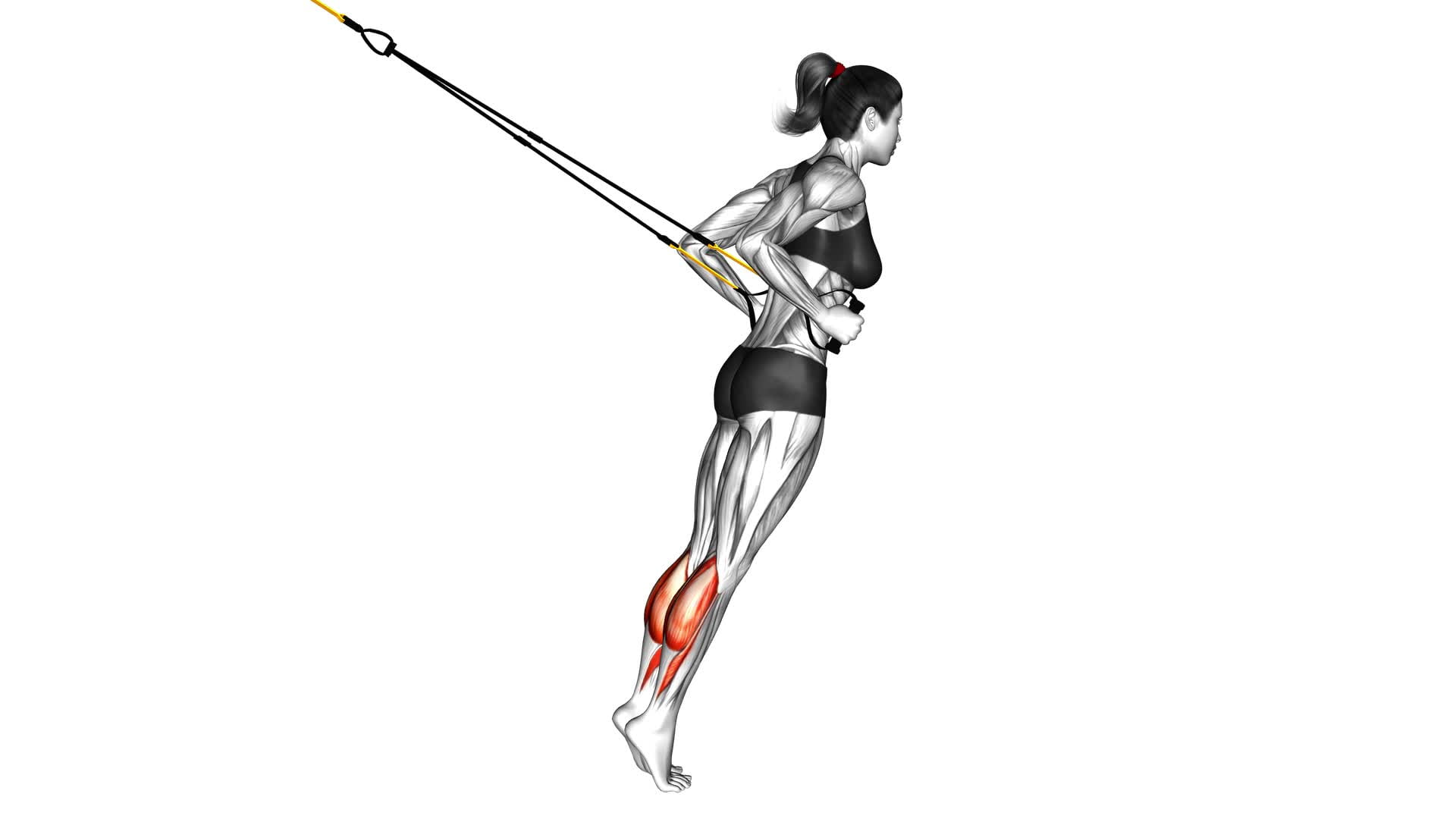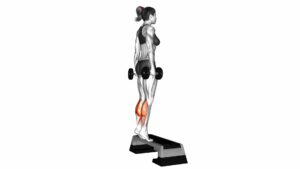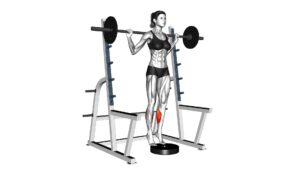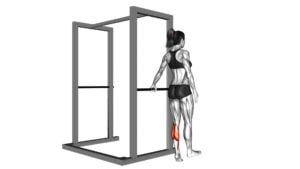Suspender Calf Raise (female) – Video Exercise Guide & Tips

Are you looking to strengthen and tone your calf muscles? Look no further than the suspender calf raise!
Watch This Exercise Video
In this quick and effective exercise, you'll use a suspension system to target your calves and improve your lower body strength.
With the help of our video exercise guide and expert tips, you'll learn the proper form, equipment setup, variations, and common mistakes to avoid.
Get ready to elevate your calf game and achieve maximum results!
Key Takeaways
- Strengthen and tone calf muscles effectively
- Targets gastrocnemius and soleus muscles
- Maintain proper body alignment and engage calf muscles
- Use a sturdy platform and pair of dumbbells for variations
Benefits of Suspender Calf Raise
To reap the benefits of the suspender calf raise, you can strengthen and tone your calf muscles effectively. This exercise targets the calf muscles, specifically the gastrocnemius and soleus, helping to build strength and definition. By adjusting your form and performing the exercise correctly, you can maximize the muscle strengthening benefits.
The suspender calf raise allows you to isolate and target the calves, providing a focused workout for this muscle group. As you raise your heels off the ground, you engage the calf muscles, forcing them to contract and work against resistance. This repetitive movement helps to strengthen and tone the calves over time.
Proper form and technique are crucial to getting the most out of the suspender calf raise. To ensure you're performing the exercise correctly, start by standing with your feet hip-width apart and your toes pointing forward. Place the straps or bands around the balls of your feet and hold onto a stable object for balance. From there, lift your heels off the ground as high as you can, feeling the contraction in your calves. Lower your heels back down to the starting position and repeat for the desired number of repetitions.
Proper Form and Technique
To perform the Suspender Calf Raise with proper form and technique, there are several key points to keep in mind.
First, focus on maintaining proper body alignment by keeping your core engaged, shoulders back, and chest lifted.
Second, activate the calf muscles by pushing through the balls of your feet and lifting your heels as high as possible.
Lastly, be aware of common form mistakes such as leaning forward or letting your knees buckle inward, and make adjustments as needed to ensure a safe and effective workout.
Body Alignment Tips
Make sure your body is properly aligned during the Suspender Calf Raise exercise to maximize effectiveness and prevent injury. Here are some tips for maintaining proper body alignment:
- Stand with feet hip-width apart and toes pointing forward to ensure proper posture.
- Engage your core muscles by pulling your belly button towards your spine.
- Keep your shoulders relaxed and down, away from your ears.
- Maintain a neutral spine by keeping your head aligned with your spine and avoiding excessive forward or backward leaning.
Muscle Activation Cues
Maintain proper form and technique for the Suspender Calf Raise exercise by focusing on muscle activation cues. To maximize the benefits of this exercise, it's important to engage the calf muscles effectively.
Start by placing the balls of your feet on the edge of a step or platform, allowing your heels to hang off. As you lift your heels, focus on contracting your calf muscles and pushing through the balls of your feet. This will activate the gastrocnemius and soleus muscles, which are responsible for the calf raise movement.
Additionally, be mindful of maintaining a controlled and steady pace throughout the exercise to optimize muscle activation.
Common Form Mistakes
When performing the Suspender Calf Raise exercise, be sure to avoid common form mistakes that can compromise proper technique and form. Here are some tips for maximum results:
- Not engaging the core: To maintain stability and maximize the benefits of the exercise, it's crucial to engage your core muscles throughout the movement.
- Using momentum: Avoid using momentum to lift your body up. Instead, focus on using your calf muscles to raise your body, and control the movement on the way down.
- Incorrect foot placement: Ensure that your feet are positioned hip-width apart and parallel to each other. This will help maintain proper alignment and prevent strain on the ankles.
- Not fully extending the ankles: To fully activate the calf muscles, make sure to fully extend your ankles at the top of the movement and squeeze the calves for a brief pause.
Equipment and Setup
To properly perform the Suspender Calf Raise exercise, you'll frequently need a sturdy platform and a pair of dumbbells. When it comes to equipment options, you have a few choices. For the platform, you can use a step, a weight bench, or even a sturdy wooden box. Just make sure that whatever you choose can support your weight and is stable enough to prevent any accidents or injuries.
As for the dumbbells, you can use any weight that challenges you without compromising your form. If you don't have dumbbells at home, you can get creative and use household items like water bottles or canned goods as makeshift weights.
Setting up at home for the Suspender Calf Raise exercise is relatively simple. Find a clear space where you have enough room to perform the exercise without any obstructions. Place your chosen platform in front of you, ensuring it's secure and won't move during the exercise.
Grab your dumbbells and hold them in each hand, allowing your arms to hang by your sides. Now you're ready to begin the exercise and work those calf muscles! Remember to maintain proper form throughout the exercise, keeping your core engaged and your movements controlled.
Variations and Progressions
Now let's explore some different variations and progressions for the Suspender Calf Raise exercise to continue challenging your calf muscles and further enhance your strength and stability.
Here are some variations and modifications you can try to add variety and intensity to your Suspender Calf Raise routine:
- Single-Leg Suspender Calf Raise: Instead of using both legs, perform the exercise on one leg at a time. This will increase the demand on your calf muscles and enhance your balance and stability.
- Weighted Suspender Calf Raise: Hold a dumbbell or a kettlebell in one hand while performing the exercise. The additional weight will increase the resistance and make the exercise more challenging.
- Explosive Suspender Calf Raise: Add an explosive element to the exercise by performing the calf raises with a jump. Push off the ground forcefully and raise your heels as high as possible. This will engage your calf muscles in a different way and improve your explosive power.
- Incline Suspender Calf Raise: Perform the exercise on an inclined surface, such as a step or a ramp. This will change the angle of the exercise and target different areas of your calf muscles.
These advanced techniques will help you take your Suspender Calf Raise to the next level and continue progressing in your fitness journey. Remember to always listen to your body and adjust the intensity and difficulty as needed.
Common Mistakes to Avoid
Avoid these common mistakes when performing the Suspender Calf Raise exercise to maximize efficiency and avoid injuries.
First, make sure to maintain proper form throughout the exercise. Keep your back straight and core engaged to prevent any unnecessary strain on your lower back. Also, avoid leaning forward or backward during the movement, as this can put excessive stress on your knees and ankles.
Another mistake to avoid is using too much weight. Start with a lighter load and gradually increase it as you gain strength and confidence. Using too much weight can compromise your form and increase the risk of injury. Additionally, remember to breathe properly during the exercise. Exhale as you raise your heels and inhale as you lower them back down.
Lastly, don't rush through the exercise. Take your time and focus on the contraction of your calf muscles. Slow and controlled movements will provide better results and minimize the risk of injury. Remember to listen to your body and stop if you experience any pain or discomfort.
Tips for Maximum Results
To get the maximum results from the Suspender Calf Raise, it's crucial to focus on proper form. Make sure you're engaging your calf muscles and not relying on momentum.
Consistency is key – performing this exercise regularly will help you see noticeable improvements in calf strength and definition.
Additionally, adjust the exercise to suit your body type and fitness level, whether that means using a lower weight or modifying the range of motion.
Proper Form Importance
For maximum results, ensure you maintain proper form throughout the Suspender Calf Raise exercise. Here are some tips to help you achieve proper form and get the most out of this exercise:
- Technique: Pay attention to your technique and focus on performing the exercise correctly. This will help you target the calf muscles effectively and avoid injury.
- Body alignment: Maintain a straight posture throughout the exercise, keeping your core engaged and your shoulders back. This will help you maintain balance and stability.
- Muscle activation cues: Focus on activating your calf muscles during the exercise. Visualize pushing through your toes and contracting your calf muscles as you lift your heels off the ground.
- Range of motion: Aim to achieve a full range of motion by lowering your heels as far as possible without discomfort. This will help you engage the calf muscles fully and maximize results.
Consistency Yields Results
To achieve maximum results and see the benefits of the Suspender Calf Raise exercise, it's important to maintain consistency in your workout routine. Consistency is key when it comes to any fitness goal, and this exercise is no exception.
By performing the Suspender Calf Raise regularly, you give your muscles the opportunity to adapt and grow stronger over time. It's also important to have patience throughout your fitness journey. Results may not come overnight, but with consistent effort, you'll see progress.
One way to stay motivated and track your progress is by keeping a workout journal or using a fitness app. By recording your sets, reps, and weights, you can see how far you've come and stay motivated to keep pushing forward.
Adjusting for Body Type
For optimal results, select the appropriate weight for your body type when performing the Suspender Calf Raise exercise. Adjusting the technique based on your body type considerations will help you maximize the benefits of this exercise.
Here are some tips to help you adjust for your specific body type:
- Height: If you're taller, you may need to use heavier weights to challenge your calf muscles effectively. Conversely, if you're shorter, lighter weights may be sufficient.
- Body Composition: Consider your body fat percentage. If you have a higher body fat percentage, you may need to use more weight to ensure the exercise is challenging enough. If you have a lower body fat percentage, lighter weights may be enough.
- Leg Length: Longer legs may require more weight to fully engage the calf muscles, while shorter legs may need less weight.
- Strength Level: Adjust the weight based on your current strength level. If you're a beginner, start with lighter weights and gradually increase as you get stronger.
Frequently Asked Questions
How Many Repetitions and Sets Should I Do of the Suspender Calf Raise Exercise?
To determine the number of repetitions and sets for the suspender calf raise exercise, it's important to consider your fitness goals and current fitness level.
Generally, aim for 3-4 sets of 10-15 repetitions, with a rest period of 30-60 seconds between sets.
This exercise helps strengthen the calf muscles, improving stability and balance.
If you're looking for alternative exercises for calf strengthening, you can try standing calf raises, seated calf raises, or calf raises on a leg press machine.
Can I Do the Suspender Calf Raise Exercise if I Have a Knee Injury?
If you have a knee injury, it's important to be cautious when doing exercises that put pressure on your knees, like the suspender calf raise.
You may want to consider alternative exercises that target your calf muscles without straining your knees.
Consult with a healthcare professional or a certified trainer for specific exercises that are safe for your knee condition.
Additionally, make sure to warm up properly, use proper form, and listen to your body to prevent knee injuries during calf exercises.
Is It Better to Perform the Suspender Calf Raise Exercise With Bodyweight or With Added Resistance?
When it comes to the suspender calf raise exercise, you might be wondering if it's better to do it with just your bodyweight or with added resistance. Well, the answer depends on your goals.
Using bodyweight alone can help improve muscle endurance and tone, while using added resistance can increase muscle strength and size.
Both methods have their benefits, so it's up to you to decide which one aligns with your fitness goals.
Can I Do the Suspender Calf Raise Exercise if I Have Weak Ankles?
If you have weak ankles, it's important to focus on strengthening exercises that can improve ankle stability.
While the suspender calf raise exercise can be beneficial for calf muscles, it may not be the best choice for weak ankles.
Instead, consider starting with exercises that specifically target ankle strength, such as ankle circles or ankle dorsiflexion exercises.
Gradually increase the intensity and difficulty of these exercises to build up your ankle strength before attempting the suspender calf raise.
Are There Any Specific Breathing Techniques I Should Follow While Performing the Suspender Calf Raise Exercise?
When performing the suspender calf raise exercise, it's important to focus on your breathing techniques and maintaining proper form.
Take a deep breath in before starting the exercise and exhale as you rise up onto your toes. Inhale as you lower yourself back down.
This helps maintain stability and control throughout the movement. Remember to stay relaxed and breathe naturally, allowing your breath to guide your movements.
Conclusion
Incorporating the suspender calf raise into your workout routine can provide numerous benefits. This exercise is known for strengthening the calf muscles and improving balance. By following proper form and technique, you can ensure that you are targeting the right muscles and avoiding injury. It is important to use the appropriate equipment, such as a calf raise machine or a set of dumbbells, to properly perform this exercise. Additionally, be mindful of common mistakes, such as using momentum instead of controlled movements or neglecting to stretch before and after the exercise. By gradually progressing and challenging yourself with variations, you can continue to see improvements in your calf muscles. Consistency and dedication are key to achieving stronger and more defined calves.

Author
Years ago, the spark of my life’s passion ignited in my mind the moment I stepped into the local gym for the first time. The inaugural bead of perspiration, the initial endeavor, the very first surge of endorphins, and a sense of pride that washed over me post-workout marked the beginning of my deep-seated interest in strength sports, fitness, and sports nutrition. This very curiosity blossomed rapidly into a profound fascination, propelling me to earn a Master’s degree in Physical Education from the Academy of Physical Education in Krakow, followed by a Sports Manager diploma from the Jagiellonian University. My journey of growth led me to gain more specialized qualifications, such as being a certified personal trainer with a focus on sports dietetics, a lifeguard, and an instructor for wellness and corrective gymnastics. Theoretical knowledge paired seamlessly with practical experience, reinforcing my belief that the transformation of individuals under my guidance was also a reflection of my personal growth. This belief holds true even today. Each day, I strive to push the boundaries and explore new realms. These realms gently elevate me to greater heights. The unique combination of passion for my field and the continuous quest for growth fuels my drive to break new ground.







